How will the Universe end? Right now cosmologists have two equally distressing scenarios mapped out for the long term fate of the Universe. On the one hand, gravity might slow down the expansion of our Universe so that it coasts to a stop and possibly even collapses back down into a Big Crunch. On the other hand, the expansion of the Universe could continue indefinitely thanks to the acceleration of dark energy. We would face a cold, lonely future as other galaxies fade away into the distance. My guest today is Eric Linder from the Lawrence Berkeley National Laboratory and he’s proposing experiments that could help us learn which of these two fates await us.
Continue reading “Podcast: The Fate of the Universe”
What’s Up This Week – September 12 – September 18, 2005
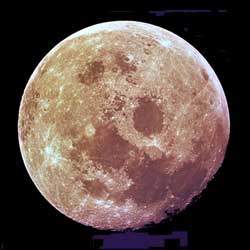
The Moon, captured by Apollo 11 astronauts. Image credit: NASA. Click to enlarge.
Monday, September 12 – If you’re up before sunrise this morning, be sure to step outside with a pair of binoculars and check out how close Saturn is to the M44. You should be able to see them both in the same field of view!
Today in 1959, the USSR’s Luna 2 scored a mark as it became the first manmade object to hit the moon. The successful mission landed in the Paulus Putredinus area, and tonight we’ll go there.
The most outstanding feature will be mid-placed Copernicus. Head northeast for Eratosthenes caught on the “tail” of the Apennine Mountains. To the northeast you will see prominent crater Archimedes with smaller craters Aristillus and Autolycus to the east. South of this pair, and caught along the mountain range, you will spy a dark grey, heart-shaped area known as the “Rotten Swamp” – Paulus Putredinus. Apollo 15 landed near Mons Hadley on its northeastern shore, but Luna 2 beat it there. Look at the area between the southern Autolycus and Archimedes. Spaseba!
Before we call it a night, why not point your scope toward the star in the northeast corner of the diamond of Delphinus? Its name is Gamma and it is one of the best double stars in this area for a small optics. Discovered by Struve in 1880, this 100 light year distant pair will show a slight yellow tinge in the fourth magnitude primary, and perhaps a little green in the fifth magnitude secondary. Enjoy it tonight…
Tuesday, September 13 – Today in 1922, the highest air temperature ever recorded at the surface of the Earth occurred. The measurement was taken in Libya burned in at a blistering 136?F, but did you know that the temperatures in the sunlight on the Moon double that? Tonight let’s take a look at a sunlit feature as we head for the bright point of crater Euler.
Beginning towards the north in the mostly disclosed Mare Ibrium region, look for this small, but conspicuous crater near the terminator. Note that it is roughly the same size as its two attendant craters to the east – Lambert and Pytheas, but has a noticeably central peak. If timing is right, you may be able to see the peak of Mons Vinogradov peeking above the terminator to its west.
For viewers in New Zealand, you will have the opportunity to watch the Moon occult Tau Sagittarius on this universal date. Please check this IOTA webpage for details.
If that’s not “hot” enough for you, then take a look straight overhead at brilliant star Vega. It is a “Sirian type” star and with a surface temperature of about 9200 degrees Kelvin, it’s twice as hot as our own Sun. At around 27 light years away, our entire solar system is moving towards Vega at a speed of 12 miles per second, but don’t worry… It will takes us another 450,000 years to get there. If we were to arrive tonight, we’d find that Vega is around 3 times larger than Sol and that it also has a 10th magnitude companion that can often be resolved in mid-sized scopes. It’s one of the first stars to ever be photographed. Back in 1850, that simple star – Vega – took and exposure time of 100 seconds through a 15″ scope. How times have changed!
Wednesday, September 14 – If you have a clear western horizon, take the time after the Sun sets to look at how far the evening planets have now moved apart. With Venus still blazing, Jupiter is becoming harder and harder to spot as it has moved a handspan away to the west. It’s almost gone…
Before we head off into the night, let’s take a look at the lunar surface. While outstanding Gassendi will catch the eye, there are more craters along the shores of Mare Humorum that deserve some attention! South of Gassendi and along the west shore is Class III crater Mersenius. Perhaps the terminator will be dividing it at the time of your viewing at it will appear like a “bite” taken out of the edge. Perhaps it will be well lit and you will see a cruciform structure of mountains and craters. Tonight its features look quite high, but by tomorrow, it will be totally washed out.
Due south of Gassendi across Mare Humorum is Doppelmeyer, who’s eroded walls have left it nothing more than a ghost of its former self – yet you can still see an upsweep in its interior landscape. If skies are stable, power up and see if you can spot Rimae Doppelmeyer to the west or the faded ruins of Puiseux on its eastern flank.
Thursday, September 15 – Head’s up, Eastern Europe! Tonight you have a chance to watch the Moon occult Epsilon Capricornii. Please check this IOTA webpage for details in your area.
Tonight on the lunar surface, we’ll visit the far north as well look towards our guidepost, Sinus Iridum. Head north once again to spot the rather unusual rectangle shape of crater Babbage. This ancient, shallow enclosure has many younger craters within it, and Babbage A will be quite clear. Heading northeast about twice the length of Babbage, you will spot a rather deformed “heart shape” that marks crater Anaximander. This will be part of a group of five overlapping craters, and the name is given essentially to the whole complex. Look for younger crater Carpenter as a black ellipse with a bright border intruding in its walls.
While you’re out, stop to look up at Beta and Gamma Lyrae, the lower two stars in the “Harp”. Beta is actually a quick changing variable which drops to less than half the brightness of Gamma in around 12 days. For a few days the pair will seem of almost equal brightness and then you will notice the star closest to Vega fades away. Beta is one of the most unusual spectroscopic stars in the sky, and it is possible that its eclipsing binary companion may be the prototype of the “collapsar”, (yep. a “black hole”!) rather than a true luminous body.
Friday, September 16 -The Moon rises shortly before Sun sets tonight amidst the difficult to see stars of the constellation Aquarius. Believe it or not, Uranus is only about 3 degrees away, but it will be next to impossible to pick the distant planet out with the lunar glare. So why ignore the Moon? Let’s do some exploring and we can start just as easily as identifying the grey oval of Grimaldi.
Just north of Grimaldi is Class V Hevelius. It will show as a bright oval, similar to Grimaldi, but will contain an off-center mountain peak. Its north wall is broken by Class I Calaverius, a narrow, bright ellipse with a thin, black border to the east. Only 100 kilometers away from here on the edge of Oceanus Procellarum lay the remains of the very first successful lunar landing. It was here on February 3, 1966 that the Soviet probe – Luna 9 – touched down. The man-sized craft sent back panoramic television images to a waiting Earth, revealing the uneven, jagged surface covered with dust. So good were the probe’s images, that scientists were even able to discern small depressions and protrusions only millimeters in size.
Saturday, September 17 – On this day in 1789, Sir William Herschel discovered Saturn’s moon Mimas. And indeed the Moon will be on our mind as tonight is “Harvest Moon”.
At exactly 10:01 p.m. EDT, the Moon will become Full and it will be the closest to the Autumnal Equinox. Because the orbit is more horizontal with the eastern horizon, it will rise a dusk for the next several nights in a row. On the average, the Moon rises about 50 minutes later each night, but at this time of year it’s around 20 minutes later for mid-northern latitudes and even faster farther north. Because of this added extra light, the name “Harvest Moon” came about because it allowed farmers more time to work in the fields.
Often times we perceive the “Harvest Moon” as being more orange than any other time of the year. The reason is not only scientific enough – but true. Coloration is caused by the scattering of the light by particles in our atmosphere. When the Moon is low, like now, we get more of that scattering effect and it truly does appear more orange. The very act of harvesting itself produces more dust and often times that coloration will last the whole night through. And we all know the size is only an “illusion”…
So, instead of cursing the Moon for hiding the deep sky gems tonight, enjoy it for what it is… A wonderful natural phenomena that doesn’t even require a telescope! Is that Mars following behind it?
Sunday, September 18 – If you’re up before dawn this morning, why not take the opportunity to step outside and look at how much the sky has changed. The winter constellation of Orion has now well risen and the harbinger of the Winter – Sirius – has now appeared.
Once again, the Moon will play a major role in tonight’s sky, but why not take the time to enjoy some of its incredible features? With just your eye you can identify Mare Crisium to the northeast, and Mare Fecundatitus to the southeast. Mare Frigorus is the long, dark stretch that runs across the northern section and the expanse of Mare Ibrium and Oceanus Procellarum dominate the northwest quadrant. Can you spot the dark oval of Mare Humorum to the southwest or Nubium to its east?
Those of you with sharp eyes might be able to make out the small dark oval of crater Plato to the north or Grimaldi to the west. Can you see the bright point of Tycho? Just north of central is the very round, grey Mare Serenitatis and south of it, Mare Tranquillitatis. Using binoculars, trace out the bright rays of Proculus in the east and Tycho to the south. Aristarchus and Kepler shine like beacons in the northwest and while the southwest is far more muted, look for the bright point of Euclides.
Hang tough. A few more days and darker skies will be on our side! Until then? May all your journeys be at light speed…. ~Tammy Plotner
Join the Bad Astronomy/Universe Today BOINC Team

Several years ago, scientists at University of California, Berkeley came across a situation in which more data was being gathered by a radio telescope than could be analyzed by any single computer. The solution to this problem was to use the idle time of personal computers all around the world. This resulted in the creation of SETI@Home, a downloadable application that would do some calculations on a very small piece of the gathered data. The results would then be returned to SETI@Home’s servers to be combined back with results from other computers all around the world. This later branched into BOINC, a project that allows one to choose from multiple projects such as SETI@Home and run many projects on one computer. The user can even allot how much time is spent on each project. BOINC runs at a low priority on one’s computer, which means when other programs (Word, Internet Explorer, etc.) request the processor, BOINC hands it over and allows the program to do as it wishes. When the program is done, BOINC picks up where it left off.
The Bad Astronomy/Universe Today forum currently has a team for four of the BOINC projects. The team is named BABB, but that will soon change when the BAUT forum name is finalized. The name will change to reflect the BAUT name. Though the team is named after the forum, those who are not a part of the forum are welcome to join.
The Einstein@Home project searches for spinning neutron stars known as pulsars by searching for gravity waves in data from the LIGO and GEO gravitational wave detectors. Anyone wishing to sign up for Einstein@Home can do so here and can sign up for the Bad Astronomy/Universe Today team by clicking join here.
The LHC@Home project allows for the simulation of a particle travelling through a large particle accelerator that is due to be completed by 2007 by CERN known as the LHC (Large Hadron Collider). Anyone wishing to sign up for Einstein@Home can do so here and can sign up for the Bad Astronomy/Universe Today team by clicking join here.
The SETI@Home project searches for evidence of extraterrestrial intelligence through radio waves received from the Arecibo Observatory. Anyone wishing to sign up for SETI@Home can do so here and can sign up for the Bad Astronomy/Universe Today team by clicking join here.
The orbit@home project will take data from observations of asteroids and calculate their orbits. This will assist in the search for any asteroids in an eventual collision course with the Earth, as well as catalogue the orbits of the asteroids. This project is not running yet, but soon will be in the test phase. Member creation is shutdown for the time being. The project will have to be tested for a while before it goes online.
The team has a web page and member stats. Any questions regarding this project can be asked at this thread on the BAUT forum or sent to [email protected].
Book Review: Voyages to the Stars and Galaxies
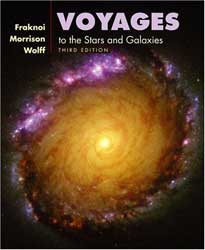
Texts on general courses need to fulfill two goals; they must explain the details, and they must capture the imagination. Those contemplating sticking their toe into the pool of astronomy could understandably get nervous. This field has contributions made from most of the greatest thinkers of our species. In addition, our primitive five senses are woefully inadequate to peel back the shrouds of astronomical mystery. Today, professionals tell tales of trying to contact aliens, go through a spacetime continuum, or detect dark energy. They rely on state-of-the-art technology using ultimate processing power and quirky algorithms to make sense of what the uninitiated would consider random patterns. Yet, in starting from the beginning and keeping the information succinct, an introductory text can supply adequate elucidation and perhaps entice another neophyte to continue past the general level.
The team of Fraknoi, Morrison and Wolff, in their textbook, meet both these goals. For astronomy, they offer completeness. To start, there’s the perspective of astrology based solidly in history. Then they proceed down the chronological path bringing in each contributor and the significant contributions. Orbits, geocentricity, eclipses and tides lay the ground work. However, the text quickly proceeds to the electromagnetic spectrum, radio telescopes, nuclear chemistry and the basis of today’s observation, that is, star types, distances and life attributes. The end brings the reader to current perceptions on relativity, cosmology, and astrobiology. There is no doubt that the authors explain the details, though for the most part they focus on data rather than on rationale.
Trying to capture an imagination without knowing the person is much more nebulous a task. Clearly, the authors assume the reader has no technical background. The powers of ten mathematics notation is the most complex math and has two solid descriptions, one in the text and the other in the appendices. Photographs, diagrams, historical vignettes and charts ease the way forward for those not used to contemplating quantitative descriptions. Analogies appear throughout. For example, did you know the density of a neutron star is similar to squeezing all the people on Earth into the volume of a single rain drop? Lastly, the accompanying CD, with the student edition of The Sky, gives many opportunities to take the data in the text and compare it to night time observations for any latitude or longitude within a time of 10 000 years. If the student truly has interest in astronomy, then this text should capture their imagination, at least until the end of the course.
As a text, this book aims solidly for course work. Each significant subject of astronomy has its own chapter. The chapter layout starts with the history, emphasizing the practitioners, next the current activity emphasizing the equipment, and then ends with expectations emphasizing the research thrusts. At the conclusion of each chapter, a summary, list of group activities, review questions and contemplative questions provide lots of study material. In a unique step, the authors have set up an adoption program whereby they keep all registered users up to date on new material. They also have a help hot line (actually email line) where they promise to quickly answer any (student or lecturer) question regarding this course work.
Given that this version is the third edition, it should and does flow smoothly. Chapters stand on their own. Different styles emerge, likely due to the different authors, but no problems result. The information is current, though it can be necessarily vague, such as the topic on our universe’s size. Also, like most texts, the contents revolves around data and is perfect for digesting and regurgitation. The sparse amount of theory is appropriate for a general introductory text.
September is the time for school and the show of Sagittarius in the night sky. School has surprises but so does Sagittarius. Did you know that within the boundaries of this constellation there lies a galaxy that’s about to get eaten up by our own Milky Way? Read the book Voyages to the Stars and Galaxies by Andrew Fraknoi, David Morrison, and SidneyWolff to learn about the constellations, stars and their marvellously unique and sometimes hungry properties. Anthropic or not, you’ll see that we’re in one amazing universe.
Review by Mark Mortimer
Read more reviews online, or purchase a copy from Amazon.com.
Audio: The Fate of the Universe
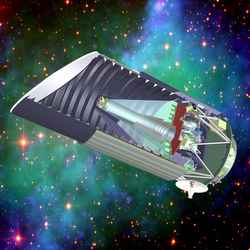
The SuperNova/Acceleration Probe, SNAP. Image credit: Berkeley Lab Click to enlarge
Listen to the interview: The Fate of the Universe (6.2 MB)
Or subscribe to the Podcast: universetoday.com/audio.xml
Fraser Cain: Can you lay out the two fates that may await our Universe?
Eric Linder: Well, our picture of what the fate of the Universe is has really changed dramatically in the last 5-10 years. We used to think it was fairly simple, it was just a matter of how much content there was in the Universe, how much matter there was. If there was enough matter, then the gravitational attraction would cause the Universe to slow down in its current expansion, and to basically re collapse and we’d have what some people call a Big Crunch to end our Universe. And if there was not enough matter, there would not be enough gravity to slow down the current expansion and it would just become more and more diffused – a colder and lonelier place to live in. In 1998, these two groups of scientists discovered a very bizarre occurrence that the expansion of the Universe was not slowing down either dramatically or even gradually, under the gravity of the matter in the Universe, but rather, it was speeding up. It was accelerating. Sort of like if you threw a baseball up in the air you know eventually it’s going to slow down, reach a peak, and usually come down back to Earth. If you throw it hard enough, it’ll go off into orbit. But here the Universe threw a baseball up in the air, and now that baseball is speeding away faster and faster. So this has completely puzzled scientists, and was completely contrary to what we were expecting. Under this new picture, the fate of the Universe appears to be that it is going to simply expand forever and ever, become colder, more diffuse, atoms will get more and more spread out, the distance between galaxies will increase. And we’ll have this fate of the Universe which is sometimes called the “Heat Death”, where everything just becomes very cold and motionless and isolated from each other.
But it depends on what’s causing this acceleration. That’s the great mystery. It’s possible that the physics giving us this acceleration could suddenly go away, in which case we’d be back to the earlier picture where the Universe might collapse. Or it could do something completely bizarre and we don’t know. So this is a big question that we want to find out. What is the fate of the Universe, but trying to figure out, what is the physics in this acceleration.
Fraser: Why has that question not been answered so far? Have we not gotten a good enough look at the supernovae?
Linder: Right, as I said, the acceleration of this expansion was only discovered in 1998. And people haven’t been sitting on their hands, they’ve been trying to answer this question very passionately. By getting more supernovae, we can use these exploding stars sort of like fireworks off in the Universe. If we know that the fireworks always go off with the same energy, with the same brightness, we can tell how far away they are by how bright they appear to us today. And so we need more of these supernovae, and we need more and more distant ones, so we can map the history of the Universe; the expansion of the Universe over a greater period of time. And people are gradually doing that. There are some very large projects underway with telescopes on the ground attempting to get what were just tens of supernovae, now we’re trying to get hundreds of supernovae. But eventually, to really answer these fundamental questions, we’re going to need thousands of supernovae at great distances. In order to get that, we’re going to need observations from space, so currently we have one space telescope – the Hubble Space Telescope – that is suitable for these sort of observations, and it’s doing a great job. It’s seeing the most distant supernovae that we’ve yet discovered; about 10 billion years out in the history of space, but it can only see them one by one. And so what scientists have proposed is that we build a new space observatory, a new telescope in space, called SNAP (Supernova Acceleration Probe), and this will be able to get thousands of supernovae very efficiently, very rapidly, seeing them extremely faint and extremely deep. And this has really caught the imagination of the science community. There have been a number of recommendations from the National Academy of Sciences, from various professional organizations, that some sort of space observatory like this will figure out: what is this mysterious physics causing this completely unusual acceleration that’s acting opposite to gravity? So there’s almost like a repulsive version of gravity that’s really going to rewrite all the physics textbooks. So a lot of people think that we really do need to go forward with these observations, more precise observations and many more observations, such as you spoke about. We just need to improve the data that we already have, and the technology is good enough that we can go out and do this. It just requires us to sit down and build the thing, and launch it and try to find out these answers.
Fraser: Now I’ve heard quite a few suggestions for what this dark energy might be. What kinds of things would you be looking for in your observations that could maybe map against some of those theories that have been put forward?
Linder: So the granddaddy of all concepts of dark energy was put forward by Albert Einstein all the way back in 1917, what he called the cosmological constant. And it didn’t agree with the observations at the time, and so it kind of went into retirement for a while. And every few decades, scientists brought it back out to say, well maybe that could explain some other observations we’ve made. And then it goes back into retirement because it doesn’t really fit. But now it seems this might be its time, to bring back this 90 year old concept from Einstein, because it can give this acceleration of the expansion of the Universe. It’s a very simple picture for how you could get this acceleration, but it doesn’t solve everything. There are some really very puzzling aspects of it. What you would think if you did some naive calculations is that it should accelerate the Universe, but should have started accelerating the Universe all the way back from the very first instant of time, and we would not have the Universe we see today if that happened. In fact, we would not have been able to get stars and galaxies and the structure that we see in the Universe. And so for some reason there has to be much much weaker than we would think as its natural value. So it’s possible that it’s the answer, but we don’t understand why it’s so weak, relative to what we think it should be. To get around that, people come up with these other ideas, this idea of quintessence, or a 5th substance to the Universe where it acts like the cosmological constant, but it varies in time, and so it can start off very weak and now today it can be dominating the expansion of the Universe. And so that’s an attractive idea, but nobody really has any first, basic idea of how to make it work exactly. Right now it’s a concept but the details haven’t been worked out on how it arises from the physics. So that’s another thing that we can be very interested in. Another possibility is the way we’ve been analyzing the data, saying, well, gravity is an attractive force, it’s given by Einstein’s Theory of General Relativity. Maybe something breaks down there. Maybe what we’re seeing is a breakdown in the theory of gravity as we understand it. People have come up with ideas that involve extra dimensions for example. Instead of just three dimensions in space, there might be an extra few dimensions in space, and that gravity is gradually sort of leaking out into this extra dimension in space and that’s making it weaker and that will act in opposition to gravity and give us acceleration. So we have all these incredibly exciting possibilities for how physics might change and we don’t know which they are. And so what we need are these very detailed observations of mapping the expansion of the Universe for example through the supernovae, these exploding stars – and there are other methods as well – to really try and decide, how are we going to rewrite the physics textbooks; which direction do we need to start erasing things in and writing new things in. So, it’s incredibly exciting for scientists who have puzzles facing them like this.
Fraser: When are these missions planned for launch? When should they be operational?
Linder: So NASA and the US Department of Energy have agreed to work together to put a mission into orbit. The general name for it is called the Joint Dark Energy Mission. And there are currently studies going on for how one would design such a space telescope. And we’re hoping that if enough public shows a strong interest, and the professional societies – like the National Academies of Sciences, which recommended such a mission. If they continue to support this, then we hope that we can go forward and launch it within about 6-7 years. So it’s very much possible that the students in school now will know the answers to things in 6-7 years that currently no professional scientist has the slightest clue for what the answer is. So it’s always very exciting to be able to tell students, and to be able to tell the public: you’re going to know things 6-7 years from now that we have no idea what the answer is right now. You’re going to be smarter in 6 or 7 years than we are right now. So it’s really an exciting endeavour to be in the middle of.
Fraser: And if you had your way, would it be fiery hot death, or cold freezing death?
Linder: I think the main thing I’d like is that it be far off. So we know the ends of the Universe are not going to be for at least 10s of billions of years – about the length of time that we’ve already had in the Universe – so it’s nothing we have to be concerned with overnight, but I don’t know what would be the best solution. You could argue that something like an overturning of Einstein’s Theory of Gravity and just a completely new framework of physics, and new territory to explore. That might be the most exciting outcome where you might have all sorts of different possibilities arising. But as you allude to, the fate of the Universe that really grabs our imagination, of everyone, from the scientists to school children.
Exotic Life Could Survive on Titan
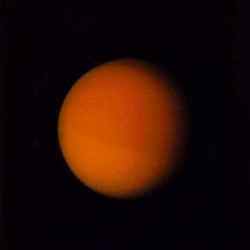
Voyager 1’s color image of Saturn’s largest satellite, Titan. Image credit: NASA/JPL Click to enlarge
Saturn’s moon Titan has long been a place of interest to astrobiologists, primarily because of its apparent similarities to the early Earth at the time life first started. A thick atmosphere composed primarily of nitrogen and abundant organic molecules (the ingredients of life as we know it) are among the important similarities between these two otherwise dissimilar planetary bodies.
Scientists have considered it very unlikely that Titan hosts life today, primarily because it is so cold (-289 degrees Fahrenheit, or -178 Celsius) that the chemical reactions necessary for life would proceed too slowly. Yet previously published data, along with new discoveries about extreme organisms on Earth, raise the prospect that some habitable locales may indeed exist on Titan.
In a paper being presented at the Division for Planetary Sciences 2005 Meeting this week, a team of researchers from Southwest Research Institute (SwRI) and Washington State University say that several key requirements for life now appear to be present on Titan, including liquid reservoirs, organic molecules and ample energy sources.
Methane clouds and surface characteristics strongly imply the presence of an active global methane cycle analogous to Earth’s hydrological cycle. It is unknown whether life can exist in liquid methane, although some such chemical schemes have been postulated. Further, abundant hints of ice volcanism suggest that reservoirs of liquid water mixed with ammonia may exist close to the surface.
“One promising location for habitability may be hot springs in contact with hydrocarbon reservoirs,” says lead author Dr. David H. Grinspoon, a staff scientist in the SwRI Space Science and Engineering Division. “There is no shortage of energy sources [food] because energy-rich hydrocarbons are constantly being manufactured in the upper atmosphere, by the action of sunlight on methane, and falling to the surface.”
In particular, the team suggests that acetylene, which is abundant, could be used by organisms, in reaction with hydrogen gas, to release vast amounts of energy that could be used to power metabolism. Such a biosphere would be, at least indirectly, solar-powered.
“The energy released could even be used by organisms to heat their surroundings, helping them to create their own liquid microenvironments,” says Grinspoon. “In environments that are energy-rich but liquid-poor, like the near-surface of Titan, natural selection may favor organisms that use their metabolic heat to melt their own watering holes.”
The team says these ideas are quite speculative but useful in that they force researchers to question the definition and universal needs of life, and to consider the possibility that life might evolve in very different environments.
“Possible Niches for Extant Life on Titan in Light of Cassini-Huygens Results” will be presented September 8 at the Division for Planetary Sciences 2005 Meeting in Cambridge, United Kingdom. Grinspoon, Dr. Mark A. Bullock, Dr. John R. Spencer (SwRI) and D. Schulze-Makuch (Washington State University) performed the study with funding from the NASA Exobiology Program using published results from the Cassini-Huygens mission. This project is not otherwise affiliated with Cassini-Huygens.
Original Source: SwRI News Release
Planets Are Born Quickly
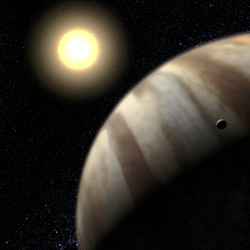
Artist’s concept of Jupiter-like planet orbiting a star. Image credit: NASA Click to enlarge
Using NASA’s Spitzer Space Telescope, a team of astronomers led by the University of Rochester has detected gaps ringing the dusty disks around two very young stars, which suggests that gas-giant planets have formed there. A year ago, these same researchers found evidence of the first “baby planet” around a young star, challenging most astrophysicists’s models of giant-planet formation.
The new findings in the Sept. 10 issue of Astrophysical Journal Letters not only reinforce the idea that giant planets like Jupiter form much faster than scientists have traditionally expected, but one of the gas-enshrouded stars, called GM Aurigae, is analogous to our own solar system. At a mere 1 million years of age, the star gives a unique window into how our own world may have come into being.
“GM Aurigae is essentially a much younger version of our Sun, and the gap in its disk is about the same size as the space occupied by our own giant planets,” says Dan Watson, professor of physics and astronomy at the University of Rochester and leader of the Spitzer IRS Disks research team. “Looking at it is like looking at baby pictures of our Sun and outer solar system,” he says.
“The results pose a challenge to existing theories of giant-planet formation, especially those in which planets build up gradually over millions of years,” says Nuria Calvet, professor of astronomy at the University of Michigan and lead author of the paper. “Studies like this one will ultimately help us better understand how our outer planets, as well as others in the universe, form.”
The new “baby planets” live within the clearings they have scoured out in the disks around the stars DM Tauri and GM Aurigae, 420 light years away in the Taurus constellation. These disks have been suspected for several years to have central holes that might be due to planet formation. The new spectra, however, leave no doubt: The gaps are so empty and sharp-edged that planetary formation is by far the most reasonable explanation for their appearance.
The new planets cannot yet be seen directly, but Spitzer’s Infrared Spectrograph (IRS) instrument clearly showed that an area of dust surrounding certain stars was missing, strongly suggesting the presence of a planet around each. The dust in a protoplanetary disk is hotter in the center near the star, and so radiates most of its light at shorter wavelengths than the cooler outer reaches of the disk. The IRS Disks team found that there was an abrupt deficit of light radiating at all short infrared wavelengths, strongly suggesting that the central part of the disk was absent. These stars are very young by stellar standards, about a million years old, still surrounded by their embryonic gas disks. The only viable explanation for the absence of gas that could occur during the short lifetime of the star is that a planet?most likely a gas giant like our Jupiter?is orbiting the star and gravitationally “sweeping out” the gas within that distance of the star.
As with last year’s young-planet findings, these observations represent a challenge to all existing theories of giant-planet formation, especially those of the “core-accretion” models in which such planets are built up by accretion of smaller bodies, which require much more time to build a giant planet than the age of these systems.
The IRS Disks team discovered something else curious about GM Aurigae. Instead of a simple central clearing of the dust disk, as in the other cases studied, GM Aurigae has a clear gap in its disk that separates a dense, dusty outer disk from a tenuous inner one. This could be either an intermediate stage as the new planet clears out the dust surrounding it and leading to a complete central clearing like the other “baby planet” disks, or it could be the result of multiple planets forming within a short time and sweeping out the dust in a more complex fashion.
GM Aurigae has 1.05 times the mass of our Sun-a near twin?so it will develop into a star very similar to the Sun. If it were overlaid onto our own Solar System, the discovered gap would extend roughly from the orbit of Jupiter (460 million miles) to the orbit of Uranus (1.7 billion miles). This is the same range in which the gas-giant planets in our own system appear. Small non-gas-giant planets, rocky worlds like Earth, would not sweep up as much material, and so would not be detectable from an absence of dust.
The Spitzer Space Telescope was launched into orbit on Aug. 25, 2003. The IRS Disks research team is led by members that built Spitzer’s Infrared Spectrograph, and includes astronomers at the University of Rochester, Cornell University, the University of Michigan, the Autonomous National University of Mexico, the University of Virginia, Ithaca College, the University of Arizona, and UCLA. NASA’s Jet Propulsion Laboratory in Pasadena, Calif., manages the Spitzer Space Telescope mission for NASA’s Science Mission Directorate, in Washington. Science operations are conducted at the Spitzer Science Center at the California Institute of Technology, also in Pasadena.
Most Distant Explosion Ever Seen
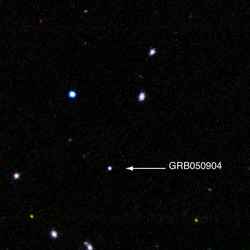
The Distant Gamma-Ray Burst GRB 050904. Image credit: ESO Click to enlarge
An Italian team of astronomers has observed the afterglow of a Gamma-Ray Burst that is the farthest known ever. With a measured redshift of 6.3, the light from this very remote astronomical source has taken 12,700 million years to reach us. It is thus seen when the Universe was less than 900 million years old, or less than 7 percent its present age.
“This also means that it is among the intrinsically brightest Gamma-Ray Burst ever observed”, said Guido Chincarini from INAF-Osservatorio Astronomico di Brera and University of Milano-Bicocca (Italy) and leader of a team that studied the object with ESO’s Very Large Telescope. “Its luminosity is such that within a few minutes it must have released 300 times more energy than the Sun will release during its entire life of 10,000 million years.”
Gamma-ray bursts (GRBs) are short flashes of energetic gamma-rays lasting from less than a second to several minutes. They release a tremendous quantity of energy in this short time making them the most powerful events since the Big Bang. It is now widely accepted that the majority of the gamma-ray bursts signal the explosion of very massive, highly evolved stars that collapse into black holes.
This discovery not only sets a new astronomical record, it is also fundamental to the understanding of the very young Universe. Being such powerful emitters, these Gamma Ray Bursts serve as useful beacons, enabling the study of the physical conditions that prevailed in the early Universe. Indeed, since GRBs are so luminous, they have the potential to outshine the most distant known galaxies and may thus probe the Universe at higher redshifts than currently known. And because Gamma-ray Burst are thought to be associated with the catastrophic death of very massive stars that collapse into black holes, the existence of such objects so early in the life of the Universe provide astronomers with important information to better understand its evolution.
The Gamma-Ray Burst GRB050904 was first detected on September 4, 2005, by the NASA/ASI/PPARC Swift satellite, which is dedicated to the discovery of these powerful explosions.
Immediately after this detection, astronomers in observatories worldwide tried to identify the source by searching for the afterglow in the visible and/or near-infrared, and study it.
First observations by American astronomers with the Palomar Robotic 60-inch Telescope failed to find the source. This sets a very stringent limit: in the visible, the afterglow should thus be at least a million times fainter than the faintest object that can be seen with the unaided eye (magnitude 21). But observations by another team of American astronomers detected the source in the near-infrared J-band with a magnitude 17.5, i.e. at least 25 times brighter than in the visible.
This was indicative of the fact that the object must either be very far away or hidden beyond a large quantity of obscuring dust. Further observations indicated that the latter explanation did not hold and that the Gamma-Ray Burst must lie at a distance larger than 12,500 million light-years. It would thus be the farthest Gamma-Ray Burst ever detected.
Italian astronomers forming the MISTICI collaboration then used Antu, one of four 8.2-m telescopes that comprise ESO’s Very Large Telescope (VLT) to observe the object in the near-infrared with ISAAC and in the visible with FORS2. Observations were done between 24.7 and 26 hours after the burst.
Indeed, the afterglow was detected in all five bands in which they observed (the visible I- and z-bands, and the near-infrared J, H, and K-bands). By comparing the brightness of the source in the various bands, the astronomers could deduce its redshift and, hence, its distance. “The value we derived has since then been confirmed by spectroscopic observations made by another team using the Subaru telescope”, said Angelo Antonelli (Roma Observatory), another member of the team.
Original Source: ESO News Release
Dusty Old Star Could Be Feeding From a Dead Planet
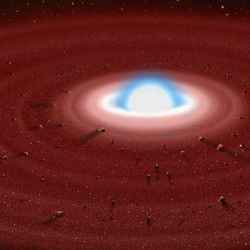
An artist’s impression of dust disk around the white dwarf GD 362. Image credit: Gemini Click to enlarge
Astronomers have glimpsed dusty debris around an essentially dead star where gravity and radiation should have long ago removed any sign of dust ? a discovery that may provide insights into our own solar system’s eventual demise several billion years from now.
The results are based on mid-infrared observations made with the Gemini 8-meter Frederick C. Gillett Telescope (Gemini North) on Hawaii’s Mauna Kea. The Gemini observations reveal a surprisingly high abundance of dust orbiting an ancient stellar ember named GD 362.
“This is not an easy one to explain,” said Eric Becklin, UCLA astronomer and principle investigator for the Gemini observations. “Our best guess is that something similar to an asteroid or possibly even a planet around this long-dead star is being ground up and pulverized to feed the star with dust. The parallel to our own solar system’s eventual demise is chilling.”
“We now have a window to the future of our own planetary system,” said Benjamin Zuckerman, UCLA professor of physics and astronomy, member of NASA’s Astrobiology Institute, and a co-author on the Gemini-based paper. “For perhaps the first time, we have a glimpse into how planetary systems like our own might behave billions of years from now.”
“The reason why this is so interesting is that this particular white dwarf has by far the most metals in its atmosphere of any known white dwarf,” Zuckerman added. “This white dwarf is as rich in calcium, magnesium and iron as our own sun, and you would expect none of these heavier elements. This is a complete surprise. While we have made a substantial advance, significant mysteries remain.”
The research team includes scientists from UCLA, Carnegie Institution and Gemini Observatory. The results are scheduled for publication in an upcoming issue of the Astrophysical Journal. The results will be published concurrently with complementary near-infrared observations made by a University of Texas team led by Mukremin Kilic at the NASA Infrared Telescope Facility, also on Mauna Kea.
“We have confirmed beyond any doubt that dust never does sleep!” quips Gemini Observatory’s Inseok Song, a co-author of the paper. “This dust should only exist for hundreds of years before it is swept into the star by gravity and vaporized by high temperatures in the star’s atmosphere. Something is keeping this star well stocked with dust for us to detect it this long after the star’s death.”
“There are just precious few scenarios that can explain so much dust around an ancient star like this,” said UCLA professor of physics and astronomy Michael Jura, who led the effort to model the dust environment around the star. “We estimate that GD 362 has been cooling now for as long as five billion years since the star’s death-throes began and in that time any dust should have been entirely eliminated.”
Jura likens the disk to the familiar rings of Saturn and thinks that the dust around GD 362 could be the consequence of the relatively recent gravitational destruction of a large “parent body” that got too close to the dead star.
GD 362 is a white dwarf star. It represents the end-state of stellar evolution for stars like the sun and more massive stars like this one’s progenitor, which had an original mass about seven times the sun’s. After undergoing nuclear reactions for millions of years, GD 362’s core ran out of fuel and could no longer create enough heat to counterbalance the inward push of gravity. After a short period of instability and mass loss, the star collapsed into a white-hot corpse. The remains are cooling slowly over many billions of years as the dying ember makes its slow journey into oblivion.
Based on its cooling rate, astronomers estimate that between two billion to five billion years have passed since the death of GD 362.
“This long time frame would explain why there is no sign of a shell of glowing gas known as a planetary nebula from the expulsion of material as the star died,” said team member and Gemini astronomer Jay Farihi.
During its thermonuclear decline, GD 362 went through an extensive period of mass loss, going from a mass of about seven times that of the sun to a smaller, one-solar-mass shadow of its former self.
Although about one-quarter of all white dwarfs contain elements heaver than hydrogen in their atmospheres, only one other white dwarf is known to contain dust. The other dusty white dwarf, designated G29-38, has about 100 times less dust density than GD 362.
The Gemini observations were made with the MICHELLE mid-infrared spectrograph on the Gemini North telescope on Mauna Kea, Hawaii.
“These data are phenomenal,” said Alycia Weinberger of the Carnegie Institution. “Observing this star was a thrill! We were able to find the remnants of a planetary system around this star only because of Gemini’s tremendous sensitivity in the mid-infrared. Usually you need a spacecraft to do this well.”
The Gemini mid-infrared observations were unique in their ability to confirm the properties of the dust responsible for the “infrared excess” around GD 362. The complementary Infrared Telescope Facility near-infrared observations and paper by the University of Texas team provided key constraints on the environment around the star.
University of Texas astronomer and co-author Ted von Hippel describes how the Infrared Telescope Facility (IRTF) observations complement the Gemini results: “The IRTF spectrum rules out the possibility that this star could be a brown dwarf as the source of the ‘infrared excess,'” von Hippel said. “The combination of the two data sets provides a convincing case for a dust disk around GD 362.”
Original Source: UCLA News Release
Full Frame Rhea
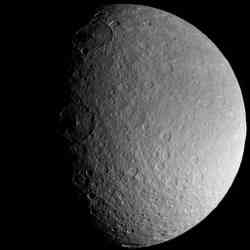
Saturn’s moon Rhea. Image credit: NASA/JPL/SSI Click to enlarge
Saturn’s moon Rhea is an alien ice world, but in this frame-filling view it is vaguely familiar. Here, Rhea’s cratered surface looks in some ways similar to our own Moon, or the planet Mercury. But make no mistake – Rhea’s icy exterior would quickly melt if this moon were brought as close to the Sun as Mercury. Rhea is 1,528 kilometers (949 miles) across.
Instead, Rhea preserves a record of impacts at its post in the outer solar system. The large impact crater at center left (near the terminator or boundary between day and night), called Izanagi, is just one of the numerous large impact basins on Rhea.
This view shows principally Rhea’s southern polar region, centered on 58 degrees South, 265 degrees West.
The image was taken in visible light with the Cassini spacecraft narrow-angle camera on Aug. 1, 2005, at a distance of approximately 255,000 kilometers (158,000 miles) from Rhea and at a Sun-Rhea-spacecraft, or phase, angle of 62 degrees. Image scale is 2 kilometers (1.2 miles) per pixel.
The Cassini-Huygens mission is a cooperative project of NASA, the European Space Agency and the Italian Space Agency. The Jet Propulsion Laboratory, a division of the California Institute of Technology in Pasadena, manages the mission for NASA’s Science Mission Directorate, Washington, D.C. The Cassini orbiter and its two onboard cameras were designed, developed and assembled at JPL. The imaging operations center is based at the Space Science Institute in Boulder, Colo.
For more information about the Cassini-Huygens mission visit http://saturn.jpl.nasa.gov . The Cassini imaging team homepage is at http://ciclops.org .
Original Source: NASA/JPL/SSI News Release
